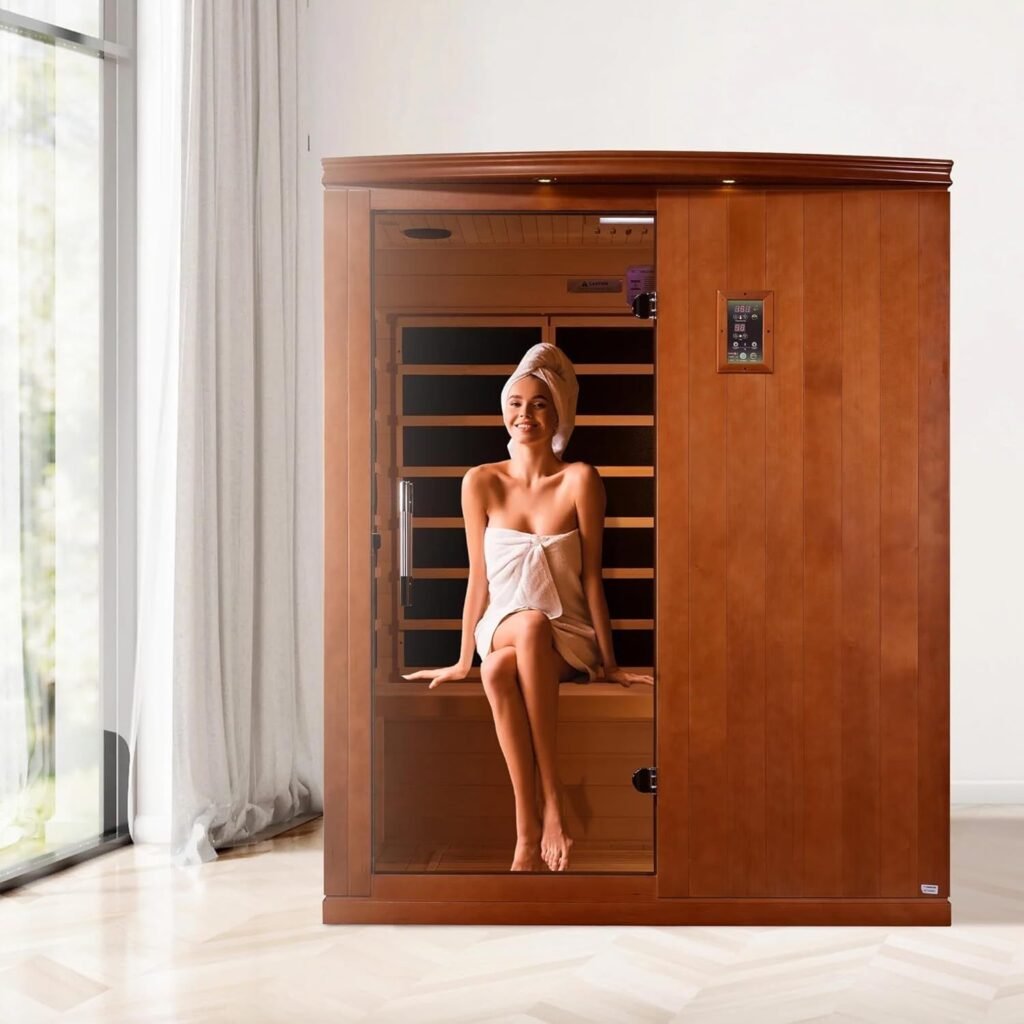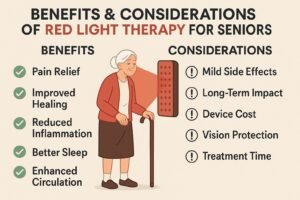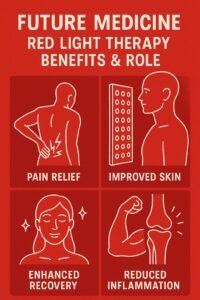Dynamic Radiant Saunas Stories: Healing & Recovery
Key Takeaways
- Dynamic radiant saunas leverage far infrared technology that penetrates deeper into tissues than traditional saunas, promoting cellular healing and recovery.
- Regular infrared sauna sessions can accelerate muscle recovery, provide natural pain relief, enhance detoxification, improve circulation, and reduce stress levels.
- Unlike traditional saunas that heat the air, infrared saunas directly warm the body at lower, more comfortable temperatures (120–140°F vs. 170–200°F).
- Haven of Heat offers premium Dynamic Saunas that combine advanced infrared technology with therapeutic benefits for comprehensive wellness.
- Creating a consistent sauna routine with proper hydration and complementary practices can maximize the healing benefits of infrared therapy.
The gentle warmth envelops your body as you close your eyes and feel the deep penetrating heat work its way into sore muscles and stiff joints. This isn’t your typical sauna experience — it’s a therapeutic journey that thousands are discovering can transform their health and recovery.
The rising popularity of infrared saunas isn’t just another wellness trend; it represents a fundamental shift in how we approach healing and recovery. These dynamic healing chambers work differently than traditional saunas, offering profound benefits that extend far beyond simple relaxation. Dynamic Saunas stand at the forefront of this revolution, providing cutting-edge infrared technology that supports the body’s natural healing mechanisms.
Radiant Heat Revolution: Why Thousands Are Turning to Infrared Saunas

Unlike conventional saunas that heat the air around you, infrared saunas use light waves to directly warm your body. This distinction is crucial — it allows for deeper tissue penetration at lower, more comfortable temperatures. The result is a more tolerable experience that produces more sweat and delivers therapeutic heat precisely where your body needs it most. Many users report being able to stay in infrared saunas longer, maximizing the healing benefits without the sometimes suffocating feeling of traditional steam saunas.
What truly sets infrared therapy apart is its ability to stimulate cellular activity. The radiant heat activates the production of ATP (adenosine triphosphate), essentially charging your body’s cellular batteries. This energy boost accelerates healing processes throughout the body, from muscle recovery to immune function. Regular sessions have been shown to increase blood flow to damaged tissues, bringing oxygen and nutrients while removing metabolic waste — nature’s perfect recipe for healing.
The therapeutic effects aren’t limited to physical healing either. Many users report profound mental clarity and emotional balance following infrared sauna sessions. The gentle warming effect triggers a parasympathetic nervous system response — your body’s “rest and digest” mode — counteracting the chronic stress that plagues modern life. This holistic approach to wellness represents what many health practitioners now recognize as true healing: addressing both body and mind simultaneously.
The Science of Deep Tissue Healing with Infrared Technology
Press enter or click to view image in full size

The magic of infrared therapy lies in the invisible spectrum of light. While we can’t see these wavelengths, our bodies respond to them at a cellular level. Far infrared wavelengths (ranging from 3 to 1,000 microns) penetrate up to 1.5 inches beneath the skin surface — reaching muscles, joints, and tissues inaccessible to conventional heating methods. This deep-tissue access is what makes infrared saunas particularly effective for chronic pain conditions and sports recovery.
How Far Infrared Waves Penetrate and Repair Damaged Cells
At the cellular level, far infrared waves create a phenomenon known as “resonance.” This gentle oscillation of water molecules generates heat within the tissues themselves rather than just warming the skin’s surface. The resonant effect increases cell membrane permeability, allowing better detoxification and nutrient absorption. Damaged cells particularly benefit from this process, as the enhanced circulation brings growth factors and healing compounds to areas of injury.
Research has shown that far infrared therapy can stimulate the production of nitric oxide, a powerful vasodilator that improves blood flow and reduces inflammation. Additionally, the deep penetrating heat activates heat shock proteins — cellular defenders that help repair damaged proteins and protect against oxidative stress. This cellular rejuvenation process explains why many users report not just temporary relief but progressive improvement in chronic conditions with regular infrared sauna use.
The healing process extends to the mitochondria — your cells’ power plants — which function more efficiently under far infrared exposure. Studies have documented increased mitochondrial energy production following infrared therapy, providing cells with the resources they need to repair and regenerate. This enhanced cellular metabolism underlies many of the systemic benefits reported by regular users, from faster workout recovery to improved immune response.
Temperature Differences: Traditional vs. Infrared Saunas
Traditional saunas operate at extremely high temperatures — typically 170–200°F — heating the air to create an intense, sometimes uncomfortable environment. These high temperatures primarily affect the skin and superficial tissues, with limited penetration to deeper problem areas. The resulting sweat is predominantly water, with minimal toxin elimination.
In contrast, infrared saunas deliver therapeutic benefits at much lower temperatures, usually between 120–140°F. This comfortable range allows for longer sessions and deeper heat penetration. The direct warming of tissues rather than air creates a more efficient heating process that many find more tolerable while producing more profuse sweating. This lower-temperature approach is particularly beneficial for those who find traditional saunas overwhelming or who have heat sensitivity issues.
The differential heating pattern also explains why infrared saunas often produce more sweat despite lower air temperatures. By directly warming the body rather than the surrounding air, they trigger the body’s cooling response more effectively. The resulting sweat contains a higher percentage of toxins compared to traditional sauna sweat, including heavy metals, cholesterol, alcohol, nicotine, and other environmental pollutants stored in fat cells.
- Traditional saunas: 170–200°F, heat the air, primarily surface sweating
- Infrared saunas: 120–140°F, heat the body directly, deeper tissue penetration
- Traditional sessions: Typically shorter (10–15 minutes) due to intense heat
- Infrared sessions: Can last 30–45 minutes, allowing greater therapeutic benefit
- Traditional benefits: Primarily relaxation and surface cleansing
- Infrared benefits: Deep tissue healing, enhanced detoxification, and cellular repair
Hemlock Wood: The Optimal Material for Healing Environments
Press enter or click to view image in full size
![]()
The construction material of an infrared sauna significantly impacts both the experience and healing benefits. Canadian Hemlock wood has emerged as the premium choice for therapeutic saunas due to its unique properties. This sustainable hardwood naturally resists warping and cracking even under repeated heating cycles, ensuring your healing sanctuary remains beautiful and functional for years.
Beyond durability, Hemlock brings inherent therapeutic qualities to the sauna experience. The wood contains natural antimicrobial compounds that help maintain a clean environment without harsh chemicals. As the wood gently warms, it releases subtle aromatic compounds that many users find calming and respiratory-supportive. This natural aromatherapy complements the physical benefits of the infrared heat, creating a multi-sensory healing experience.
“The first time I stepped into my Dynamic Hemlock sauna, I noticed the difference immediately. There’s a clean, earthy scent that puts you at ease, and the wood feels incredibly smooth against your skin even as it warms. After three months of regular use, my chronic shoulder pain has decreased by about 70%, and I’m sleeping better than I have in years.” — Michael R., Competitive Swimmer
5 Remarkable Recovery Benefits You’ll Experience
Press enter or click to view image in full size
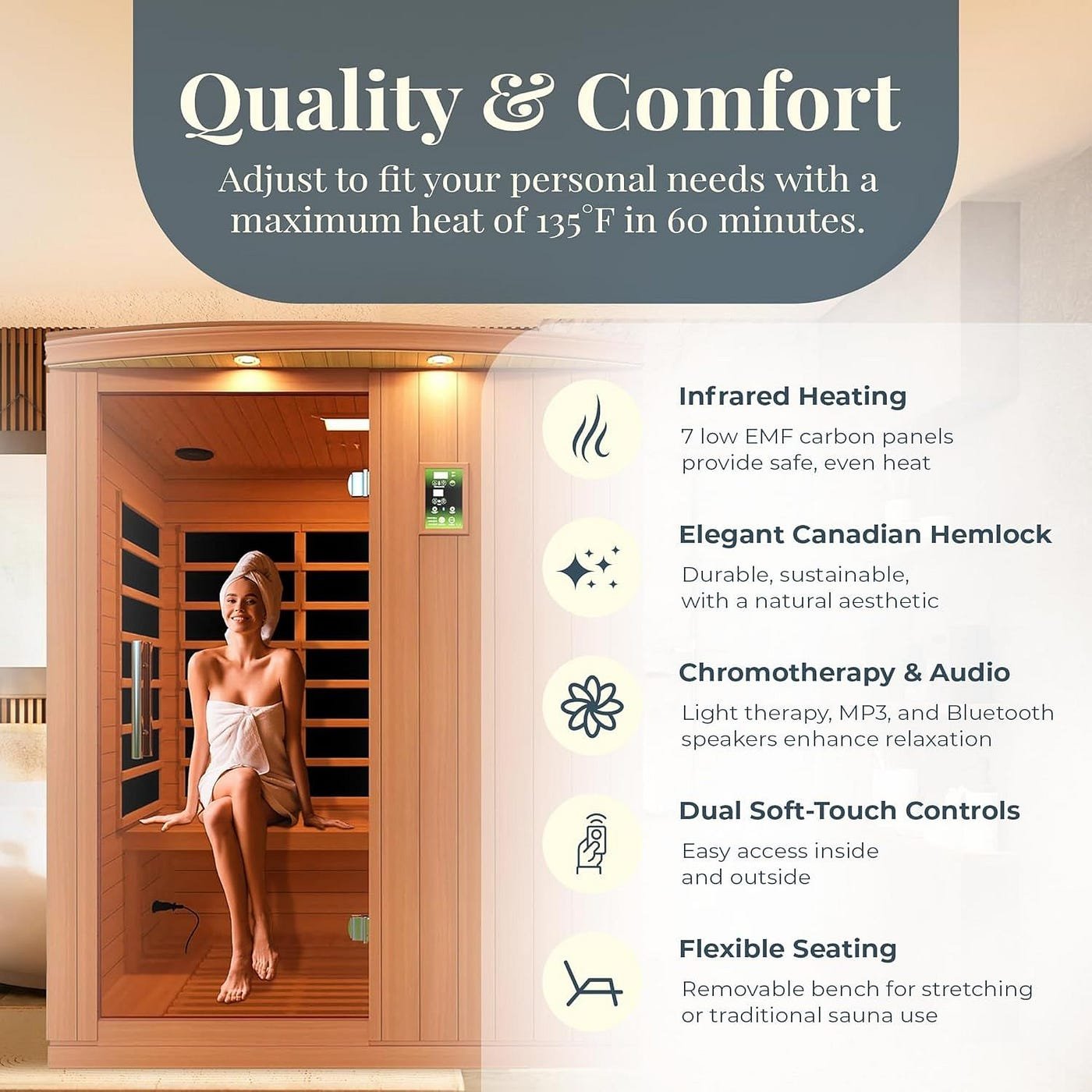
The therapeutic potential of infrared saunas extends far beyond simple relaxation. Regular sessions create a cascade of physiological responses that support healing on multiple levels. From professional athletes to those managing chronic conditions, users report transformative effects that conventional treatments often fail to deliver. Let’s explore the five most significant recovery benefits that make infrared therapy a cornerstone of many healing protocols.
1. Accelerated Muscle Repair After Intense Workouts
The deep penetrating heat of infrared saunas works wonders for muscle recovery. When muscles are damaged during exercise, microscopic tears form in the tissue fibers — this is a normal part of building strength, but it’s also what causes post-workout soreness and stiffness. Infrared heat increases blood flow specifically to these damaged areas, delivering oxygen and nutrients essential for repair while flushing out lactic acid and other metabolic waste products.
Studies have shown that regular infrared sauna sessions can reduce recovery time by up to 50% for some athletes. The increased circulation not only speeds healing but also helps prevent the formation of adhesions and scar tissue that can limit range of motion. Many professional training facilities now incorporate infrared therapy as a standard element in their recovery protocols, recognizing its superior benefits compared to traditional methods like ice baths or passive rest.
The muscle recovery benefits extend beyond just relieving soreness. Regular sauna users report improved muscle tone, enhanced flexibility, and greater resistance to future injury. This protective effect stems from improved tissue elasticity and the strengthening of connective tissues that support muscles and joints. For anyone engaged in regular physical activity, this translates to more consistent training and fewer setbacks due to injury.
2. Natural Pain Relief Without Medication
One of the most profound benefits of infrared therapy is its ability to alleviate pain without pharmaceuticals. The deep heat stimulates sensory receptors in the skin, essentially “closing the gate” to pain signals traveling to the brain — a mechanism similar to how prescription pain medications work but without the side effects or potential for dependency. This natural pain relief can last for hours after a session, providing a welcome respite for those with chronic conditions.
The analgesic effects go beyond simple heat application. Infrared therapy increases the production of endorphins — the body’s natural pain killers — while reducing the levels of cortisol and other stress hormones that can amplify pain perception. This dual-action approach explains why many users report more profound and lasting relief compared to conventional heat treatments like heating pads or hot tubs.
For conditions like arthritis, fibromyalgia, and neuropathic pain, infrared saunas offer particularly promising results. The penetrating heat reaches deep into affected joints and tissues, reducing inflammation at its source rather than just masking symptoms. Many users have been able to reduce their reliance on prescription pain medications, experiencing not only pain relief but also improvements in their overall quality of life and functional capacity.
3. Enhanced Detoxification Through Deep Sweating
Our bodies are constantly exposed to environmental toxins through air, water, food, and even personal care products. While the liver and kidneys handle most detoxification duties, the skin — our largest organ — plays a crucial role in eliminating certain compounds, particularly fat-soluble toxins that can accumulate in tissues. Infrared saunas create the ideal conditions for this dermal detoxification through deep, profuse sweating.
The composition of sweat produced during an infrared session differs significantly from that produced during exercise or in traditional saunas. Research has detected substantial amounts of heavy metals, cholesterol, alcohol, nicotine, sulfuric acid, and other environmental toxins in infrared sauna sweat. The direct heating of tissues mobilizes these substances from their storage sites in fat cells, allowing them to be eliminated through the skin.
This enhanced detoxification supports overall healing by reducing the body’s toxic burden. When fewer resources are devoted to managing accumulated toxins, more energy becomes available for repair and regeneration. Many users report improvements in skin clarity, digestion, energy levels, and mental focus — all indirect benefits of reducing the body’s chemical load through regular infrared sauna sessions.
4. Improved Circulation and Heart Health
The cardiovascular benefits of infrared sauna therapy are particularly noteworthy. As the body works to cool itself during a session, heart rate increases by 50–75%, cardiac output improves, and blood vessels dilate — creating what some researchers call a “passive cardiovascular workout.” This increased circulation delivers oxygen and nutrients to tissues throughout the body while supporting the removal of metabolic waste products.
Regular sessions have been shown to improve endothelial function (the health of blood vessel linings) and reduce both systolic and diastolic blood pressure in many users. One study found that men who used saunas 4–7 times weekly had a 50% lower risk of cardiovascular-related death compared to those who used saunas only once weekly. While infrared therapy should complement rather than replace exercise, it offers significant circulatory benefits, particularly for those with limited mobility.
Beyond these immediate effects, infrared therapy appears to improve long-term cardiovascular health markers. Regular users often see reductions in total cholesterol and improvements in the ratio between HDL (“good”) and LDL (“bad”) cholesterol. The anti-inflammatory effects of infrared heat may also reduce arterial inflammation, a key factor in heart disease development. These cardiovascular benefits make infrared saunas a valuable component of any heart health program.
5. Stress Reduction and Mental Clarity
Perhaps the most universally reported benefit of infrared sauna therapy is its remarkable effect on stress and mental well-being. The deep penetrating heat activates the parasympathetic nervous system — our “rest and digest” mode — counteracting the chronic sympathetic (“fight or flight”) activation that characterizes modern stress. This physiological shift is accompanied by decreased cortisol levels and increased production of mood-enhancing neurotransmitters like serotonin.
The mental clarity many users experience after sessions appears linked to improved blood flow to the brain and the release of specific heat shock proteins that protect neural tissue. Regular infrared sauna users report better sleep quality, reduced anxiety, improved concentration, and enhanced cognitive performance. For those dealing with mental fog, chronic stress, or mild depression, infrared therapy offers a natural, non-pharmaceutical approach to symptom management.
Real Healing Journeys: Before and After Transformations
Press enter or click to view image in full size
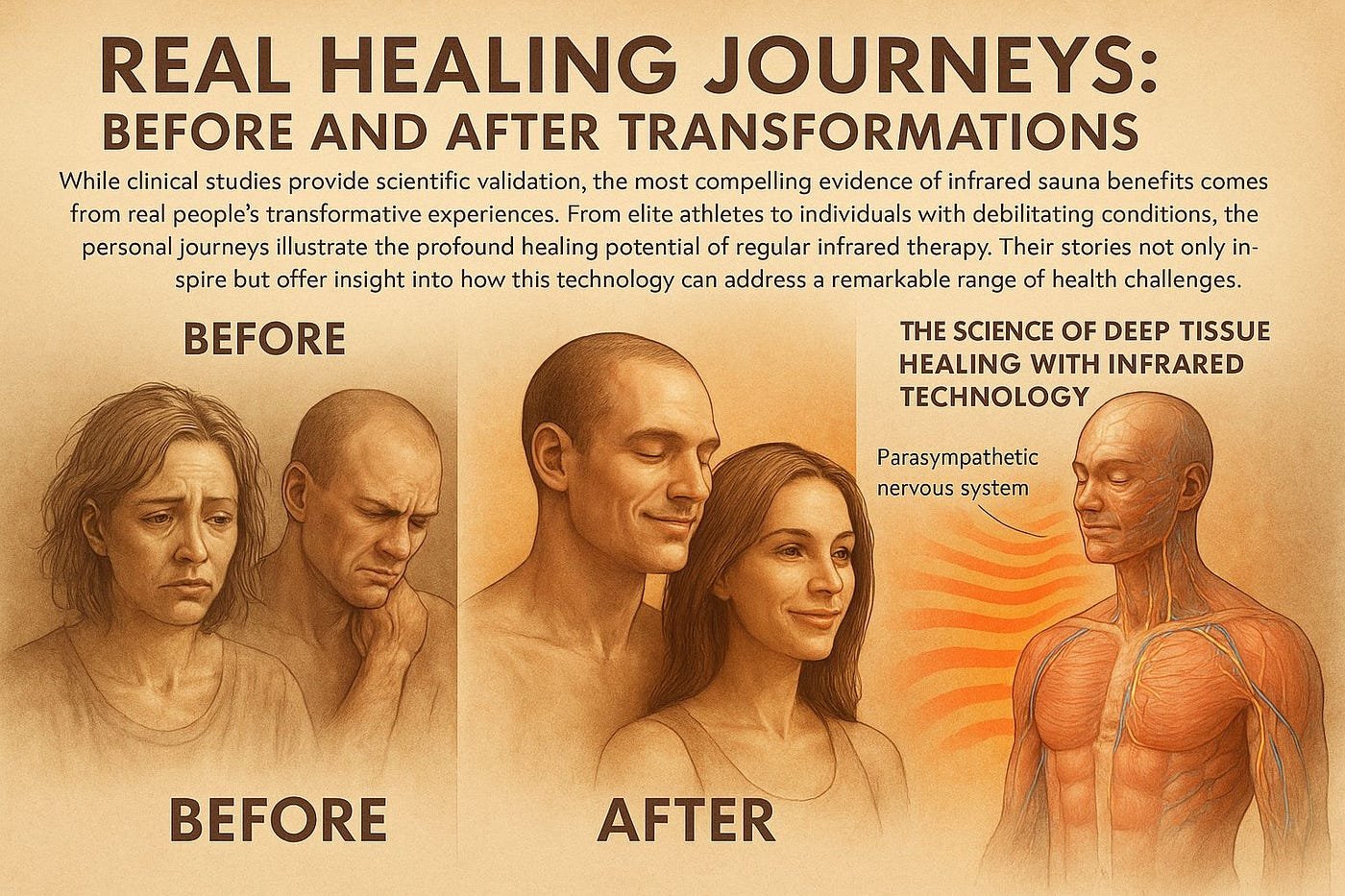
While clinical studies provide scientific validation, the most compelling evidence of infrared sauna benefits comes from real people’s transformative experiences. From elite athletes to individuals with debilitating conditions, these personal journeys illustrate the profound healing potential of regular infrared therapy. Their stories not only inspire but offer insight into how this technology can address a remarkable range of health challenges.
Pro Athletes Who Swear By Infrared Recovery
Professional athletes were among the earliest adopters of infrared sauna technology, recognizing its unique ability to accelerate recovery between intense training sessions. NBA star LeBron James incorporated infrared therapy into his recovery routine years ago, crediting it with extending his peak performance well into his 30s. His custom recovery protocol includes 40-minute infrared sessions following games to reduce inflammation and prepare his body for the next performance.
Olympic swimmers have embraced infrared therapy for its dual benefits of muscle recovery and respiratory support. Gold medalist Michael Phelps incorporated regular infrared sessions during his training, noting improvements in both physical recovery and mental focus. The therapy’s ability to clear lactic acid while supporting deep tissue healing made it particularly valuable during his most intensive training periods, allowing for consistent performance despite grueling workout schedules.
Chronic Pain Sufferers Finding Relief After Years of Struggle
For those battling chronic pain conditions, infrared saunas often provide breakthrough relief when other therapies have failed. Sarah, a 42-year-old fibromyalgia patient, had tried numerous medications and physical therapy protocols with limited success before discovering infrared therapy. “After my first month of three weekly sessions, I experienced my first pain-free day in seven years,” she reports. “Now, two years later, I maintain two sessions weekly and have reduced my pain medication by 80% while increasing my active hours per day from 2–3 to 6–8.”
Arthritis sufferers represent another group finding significant relief through infrared therapy. Robert, a 68-year-old with severe rheumatoid arthritis, had reached a point where opening a jar or buttoning a shirt had become nearly impossible despite aggressive medication. After incorporating 30-minute infrared sessions four times weekly, he experienced a 60% reduction in morning stiffness and substantially improved hand dexterity within three months. “The difference between my before and after is like night and day,” he shares. “I’ve regained independence I thought was lost forever.”
Weekend Warriors Extending Their Active Years
It’s not just professional athletes who benefit from infrared therapy — weekend warriors and active adults are discovering its ability to extend their physical prime. James, a 56-year-old avid cyclist, found himself facing increasing recovery times after his weekend rides. “By Sunday evening, I was so stiff I could barely walk down stairs, and it would take until Wednesday to feel normal again,” he explains. After adding twice-weekly infrared sessions to his routine, his recovery window shrunk dramatically to just 24 hours, allowing him to add a mid-week ride to his schedule.
Many adults in their 40s, 50s, and beyond report similar experiences — infrared therapy allows them to maintain activity levels they thought were permanently behind them. The therapy’s ability to reduce inflammation, support tissue repair, and improve joint mobility creates a perfect trifecta for extending active years. For many, this means continuing beloved activities rather than surrendering to the limitations traditionally associated with aging.
The psychological benefits for these recreational athletes shouldn’t be underestimated either. Maintaining physical activities that bring joy and satisfaction contributes significantly to mental well-being and quality of life. By supporting faster recovery and reducing injury risk, infrared therapy helps preserve not just physical capacity but also the emotional and social benefits that come with staying active.
How Different Sauna Brands Compare for Specific Health Needs
With infrared therapy’s rising popularity, numerous brands now compete for market share, each with distinct features and capabilities. Understanding these differences is crucial for selecting the option best suited to your specific healing goals. Factors like heater type, EMF levels, wavelength coverage, and construction materials significantly impact both the experience and therapeutic benefits.
Dynamic Sauna Models and Their Unique Features
Dynamic Saunas have earned their reputation through thoughtful design that prioritizes therapeutic effectiveness. Their models utilize carbon fiber heating panels that distribute infrared energy evenly throughout the cabin, eliminating the “hot spots” common in less sophisticated designs. This even heat distribution ensures that every area of your body receives consistent therapeutic exposure, maximizing healing benefits during each session.
A standout feature of Dynamic Saunas is their advanced digital control systems that allow precise temperature management and timing. This level of control enables users to customize sessions for specific healing goals — whether that’s deep detoxification, pain relief, or cardiovascular conditioning. The intuitive interface makes it easy to create and maintain personalized therapy protocols, an important factor for those using infrared therapy to address specific health conditions.
Construction quality sets Dynamic models apart from many competitors. The premium Canadian Hemlock wood used in their cabins offers natural antimicrobial properties while withstanding the repeated heating cycles that cause warping and cracking in lesser materials. Their tempered glass doors and windows create an open, inviting environment while maintaining heat efficiency, addressing the claustrophobia concerns some users have with enclosed sauna spaces.
Full-Spectrum vs. Far Infrared: Choosing What’s Right for You
The infrared spectrum includes three distinct wavelength ranges — near, mid, and far — each penetrating tissues at different depths and producing unique therapeutic effects. Far infrared (6–12 microns) penetrates deepest into the body, reaching muscle tissue, joints, and internal organs. This wavelength excels at pain relief, improved circulation, and detoxification, making it ideal for those focused on these healing goals.
Full-spectrum saunas incorporate all three infrared wavelengths, providing a more comprehensive therapeutic experience. Near infrared (0.7–1.5 microns) primarily affects the skin’s surface and outer tissues, supporting wound healing and skin regeneration. Mid infrared (1.5–5.6 microns) penetrates to soft tissues, enhancing circulation and oxygen delivery to muscles. For those seeking the broadest range of benefits, especially for skin conditions or superficial tissue injuries alongside deeper healing, full-spectrum models offer the most versatile option.
Your specific health priorities should guide this choice. Those primarily concerned with deep tissue healing, chronic pain, or detoxification may find far infrared models completely sufficient and more affordable. Individuals focusing on skin rejuvenation, wound healing, or addressing multiple health concerns simultaneously may benefit from the comprehensive approach of full-spectrum technology. Either option delivers superior therapeutic benefits compared to traditional saunas or simple heat applications.
Low-EMF Options for Electromagnetic Sensitivity
As infrared sauna popularity has grown, so has awareness of electromagnetic field (EMF) exposure during sessions. All electrical devices, including infrared heaters, produce some level of electromagnetic radiation. While research hasn’t demonstrated clear health risks from the low levels typically found in infrared saunas, many users prefer to minimize unnecessary exposure, particularly those with electromagnetic hypersensitivity.
Dynamic Saunas addresses this concern with low-EMF and ultra-low-EMF models that incorporate advanced shielding technology. These designs reduce EMF exposure to nearly background levels without compromising heating effectiveness. The attention to this detail reflects the brand’s commitment to creating the safest possible healing environment, particularly important for those using saunas to recover from health challenges.
For those particularly concerned about EMF exposure, it’s worth noting that Dynamic’s ultra-low-EMF models typically measure below 1 milligauss at the bench seating position — far below the levels found in many household appliances. This attention to electromagnetic hygiene makes these models particularly suitable for sensitive individuals or those using infrared therapy as part of a comprehensive approach to environmental illness recovery.
Creating Your Perfect Healing Routine
Press enter or click to view image in full size

Maximizing the therapeutic benefits of infrared sauna therapy requires more than simply purchasing quality equipment — it demands a thoughtful approach to session frequency, duration, temperature, and supporting practices. Creating a personalized protocol that addresses your specific healing goals while respecting your body’s limitations will yield the most profound and sustainable results. Let’s explore how to craft your optimal healing routine.
Optimal Session Length and Frequency
For most health objectives, consistency outweighs intensity when it comes to infrared therapy. Research suggests that regular, moderate sessions produce more sustainable healing benefits than occasional extended exposures. Most experts recommend starting with 20–30 minute sessions three to four times weekly, gradually increasing to 30–45 minutes as tolerance develops. This frequency provides sufficient therapeutic stimulus while allowing the body adequate time to respond and adapt between exposures.
Those new to infrared therapy should begin with shorter sessions at lower temperatures, perhaps just 15–20 minutes at 110–120°F. This gradual introduction allows your body to adapt to the detoxification process and heat stress, reducing the likelihood of detox symptoms like headaches or fatigue. As comfort increases, both duration and temperature can be incrementally increased to optimize therapeutic benefits while maintaining a pleasant experience.
For specific healing goals, frequency often matters more than session length. Chronic pain management typically responds best to consistent daily or every-other-day sessions, while detoxification protocols might involve more intense but less frequent exposures. Recovery from acute injuries often benefits from twice-daily shorter sessions during the initial healing phase, transitioning to once-daily maintenance as improvement occurs. Listen to your body’s responses and adjust accordingly — healing should feel supportive, not depleting.
Temperature Settings for Different Recovery Goals
Different therapeutic objectives respond optimally to specific temperature ranges within the infrared sauna. For pain relief and muscle recovery, higher temperatures between 130–140°F mobilize blood flow to damaged tissues while triggering endorphin release. Detoxification processes activate most effectively in the 125–135°F range, warm enough to produce profuse sweating without overstraining the cardiovascular system. Stress reduction and sleep improvement often respond best to gentler sessions around 110–125°F, which activate the parasympathetic nervous system without creating additional physiological stress.
Complementary Practices to Enhance Sauna Benefits
Strategic pairing of infrared therapy with complementary practices can dramatically amplify healing outcomes. Gentle stretching immediately following sauna sessions takes advantage of increased tissue elasticity, improving flexibility and range of motion while reducing adhesion formation. Many physical therapists recommend this combination for rehabilitation protocols, noting faster functional improvement compared to either modality alone.
Contrast therapy — alternating between infrared heat and cold exposure — creates a powerful circulatory stimulus that accelerates recovery from intense exercise or injury. A simple protocol involves 20–30 minutes in the infrared sauna followed by a brief (30–60 second) cold shower, repeated for 2–3 cycles. This practice enhances circulation while reducing inflammation more effectively than either heat or cold alone, making it particularly valuable for athletes and those recovering from acute injuries.
Hydration Strategies for Maximum Results
Proper hydration forms the foundation of effective infrared therapy, supporting both the sweating process and the elimination of mobilized toxins. Begin hydrating at least two hours before your session, aiming for 16–20 ounces of water with a pinch of high-quality salt to maintain electrolyte balance. During longer sessions, sipping room temperature water helps replace fluid losses without shocking the body with cold liquid. Post-session, rehydration should include both water and electrolytes — coconut water, a homemade electrolyte drink, or a high-quality electrolyte supplement can restore mineral balance more effectively than plain water alone.
Your Healing Journey Starts Today
The transformative potential of infrared sauna therapy awaits, offering a natural, effective approach to recovery and healing that thousands have already discovered. Whether you’re seeking relief from chronic pain, enhanced athletic recovery, stress reduction, or simply improved overall wellness, the gentle radiant heat of a quality infrared sauna provides a powerful tool for achieving your health goals. With consistent use and proper protocol, many users report not just symptom management but profound healing that conventional approaches alone couldn’t deliver. Haven of Heat’s collection of Dynamic Saunas represents the ideal starting point for your infrared healing journey, combining advanced technology with therapeutic design to maximize your results.
Frequently Asked Questions
As infrared sauna therapy continues gaining popularity, new users naturally have questions about what to expect, optimal practices, and safety considerations. Below, we address the most common inquiries to help you navigate your infrared healing journey with confidence and clarity.
How soon will I feel results from regular infrared sauna sessions?
Most users notice some immediate benefits — including improved sleep quality, reduced muscle tension, and enhanced relaxation — after their very first infrared session. These acute effects typically last 24–48 hours following exposure. More substantial healing benefits, such as significant pain reduction, improved cardiovascular markers, or skin changes, generally emerge after 2–4 weeks of consistent use (3–4 sessions weekly). Chronic conditions like arthritis or fibromyalgia may require 6–8 weeks of regular sessions before maximum improvement is achieved, though incremental benefits often appear much sooner. The key factor in determining response time is consistency — sporadic use produces less reliable and dramatic results than a regular protocol.
Can infrared saunas help with specific conditions like arthritis or fibromyalgia?
Clinical research and extensive user experiences suggest that infrared sauna therapy can significantly benefit both arthritis and fibromyalgia sufferers. For arthritis patients, the deep penetrating heat increases circulation to affected joints, reducing inflammation and pain while improving mobility. Studies have documented reduced stiffness, decreased pain scores, and improved physical function in arthritis patients following regular infrared therapy. Fibromyalgia responds particularly well to infrared treatment, with research showing improvements in pain levels, sleep quality, and overall quality of life measures. The therapy’s ability to stimulate circulation while triggering natural pain-relieving mechanisms makes it especially valuable for these often-challenging conditions where conventional treatments may provide incomplete relief.
What’s the difference between Dynamic Saunas and other infrared brands?
“After researching dozens of infrared sauna brands, I chose Dynamic for their attention to heating technology and construction quality. Two years later, I couldn’t be happier with my decision. The even heat distribution makes every session comfortable, and their customer service has been exceptional whenever I’ve had questions. My chronic back pain has improved dramatically, and I’m sleeping better than I have in years.” — Jennifer T., Yoga Instructor
Dynamic Saunas distinguish themselves through several key differentiators that impact both the user experience and therapeutic outcomes. Their proprietary carbon fiber heating elements provide more uniform heat distribution compared to ceramic tube heaters used in many competing models. This even heating ensures consistent therapeutic exposure throughout the cabin, eliminating the “hot spots” and “cold zones” that can compromise comfort and results in lesser designs.
Construction quality represents another significant advantage of Dynamic models. They utilize Canadian Hemlock wood known for its durability, natural antimicrobial properties, and resistance to warping through repeated heating cycles. The precision joinery and solid wood construction create a more durable, longer-lasting healing environment compared to thin veneer construction found in some budget alternatives. This quality difference becomes increasingly apparent over years of regular use.
Perhaps most importantly, Dynamic Saunas incorporate comprehensive EMF shielding that reduces electromagnetic exposure to near-background levels without compromising heating effectiveness. For those using infrared therapy as part of a healing protocol, this attention to electromagnetic hygiene provides peace of mind and eliminates a potential stress factor during sessions. Combined with their intuitive control systems and excellent customer support, these features make Dynamic a preferred choice for those serious about infrared therapy’s healing potential.
Are there any people who shouldn’t use infrared saunas?
While infrared sauna therapy is generally safe for most individuals, certain conditions warrant caution or medical consultation before beginning. Pregnant women should avoid infrared saunas, particularly during the first trimester, as elevated core body temperature may pose risks to fetal development. Those with unstable cardiac conditions, including recent heart attacks, uncontrolled high blood pressure, or congestive heart failure, should consult their cardiologist before beginning infrared therapy, as the cardiovascular adaptations during sessions may temporarily stress the system.
Individuals with certain implanted medical devices, particularly older pacemaker models, should exercise caution and obtain medical clearance before using infrared saunas. Similarly, those with multiple sclerosis or other heat-sensitive neurological conditions may experience temporary symptom exacerbation during or after sessions and should work closely with their healthcare provider to determine appropriate protocols. If you’re taking medications that affect heat sensitivity, sweating, or blood pressure regulation, a healthcare consultation is advisable before beginning regular infrared therapy.
How much space do I need to install a home infrared sauna?
Space requirements for home infrared saunas are surprisingly modest, making them accessible for most living situations. Single-person models require approximately 3′ × 3′ of floor space, while two-person units typically need about 4′ × 4′. Larger family-sized models may require up to 6′ × 5′ of floor space. Ceiling height considerations are equally important — most units require at least 7′ of vertical clearance to accommodate their height plus necessary ventilation space above.
Beyond the sauna’s physical dimensions, consider access requirements for installation and maintenance. Most models arrive in flat-packed panels that must be carried through doorways and assembled in place. Standard doorway widths (30–36″) typically accommodate these panels without issue, but tight corners or spiral staircases may present challenges. Dynamic Saunas are designed for straightforward assembly, with most models requiring only 2–4 hours for complete installation.
Installation requirements are minimal compared to traditional saunas. Infrared models plug into standard household electrical outlets (typically requiring a dedicated 15–20 amp circuit), eliminating the need for specialized wiring in most cases. They operate efficiently without producing excess moisture, so no special ventilation or plumbing is required. This plug-and-play functionality makes them suitable for various locations, including basements, spare bedrooms, home gyms, or even master bathroom suites.
For apartment dwellers or those with very limited space, portable infrared sauna options exist. These compact units accommodate a seated user while occupying minimal floor space and can be folded for storage when not in use. While they don’t offer the full immersive experience of cabin-style saunas, they provide many of the same therapeutic benefits in situations where space constraints would otherwise make infrared therapy inaccessible.
